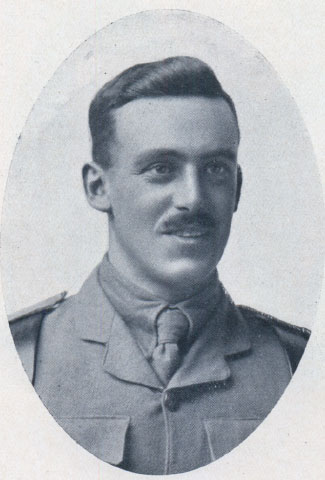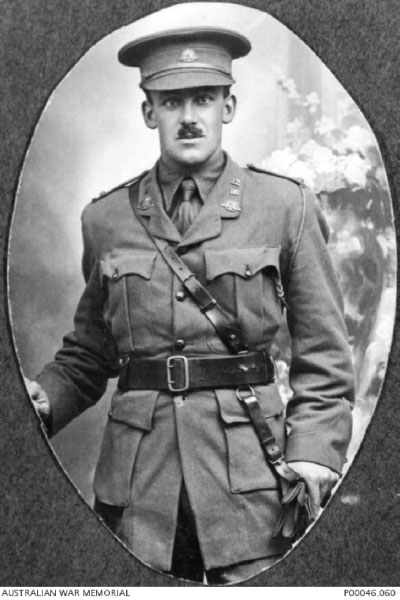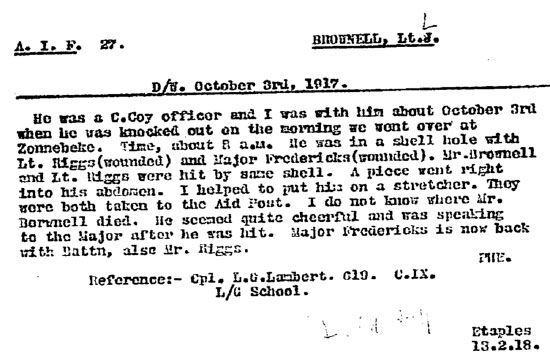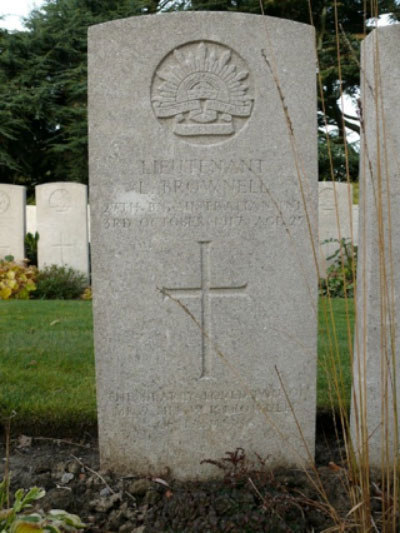War Memorial Hall c1929

Lauriston BROWNELL

Lauriston ‘Laurie’ Brownell was born on 26 December 1892 in Hobart, Tasmania. His parents were William Percival and Julie Ann James (née Scott) Brownell. He attended Scotch in 1910. He also attended the Friends’ School in Hobart. He was in Cadets at Scotch.
Laurie was a grazier when he enlisted on 3 September 1915 in Hobart, Tasmania. He served in the 27th Battalion with the rank of Lieutenant.
Laurie died on 3 October 1917 at the 10th Casualty Clearing Station in Belgium. He was 24 years of age.
Service record
Laurie Brownell was initially allocated as a 2nd Lieutenant to the 19th Reinforcements to the 12th Battalion. He embarked from Hobart for overseas on 8 August 1916, reaching Plymouth, England on 30 September. He was transferred to the 27th Battalion on 18 November 1916, but did not immediately join the unit, which was in France.
On 2 December he qualified as an Instructor at the Southern Command Bombing School at Lyndhurst, England. The following month, on 22 January 1917, he proceeded overseas to France. On 5 February he finally joined the 27th Battalion. He became a full Lieutenant on 24 February 1917. In mid-April he went to hospital with influenza, and rejoined three weeks later. On 12 May he was detached for duty at 2nd Divisional Headquarters as an ADC (aide-de-camp) to the commander of the 2nd Division: General Smyth VC until 22 May, then General Rosenthal. That work ended on 24 June, and by July he was back with his battalion.
It is interesting to speculate whether this change was related to Rosenthal’s appointment. It put Laurie in the firing line. The 1917 Collegian mentioned that he had on one occasion been in ‘an old shell hole full of water just outside the German line, and protected his men while they retired, by using his rifle and keeping the enemy quiet. He was left’, the article continues, ‘in No Man’s Land alone. He then drew plans and secured some papers containing valuable information.’ Only some hours after dark did he return to his lines. He was also in a shell hole when he was wounded severely by a shell at Ypres on 3 October 1917.
His Red Cross Wounded and Missing file contains several accounts of his death. One is by Corporal Lambert, who said he was present when he was ‘knocked out’ on the morning of 3 October (see below). Laurie and two other officers were occupying a shell hole when an explosion wounded all three. According to Lambert, a shell fragment went into Brownell’s abdomen, and this squares with Laurie’s service record. Lambert said he helped to put Brownell on a stretcher, and that he was quite cheerful and talkative after he was hit. He died at the 10th Casualty Clearing Station that day. Another eyewitness, whose testimony is not entirely reliable, says Laurie died within half an hour, and was unconscious throughout. He says entirely plausibly that Laurie was ‘very well liked by all the men’.
Laurie Brownell is buried in the Lijssenthoek Military Cemetery (Plot XX, Row D, Grave No. 8), Belgium.
Photographs and Documents:

A studio portrait of Laurie Brownell made in about 1916

Account of Laurie’s fatal wounding, from his Red Cross Wounded and Missing file.

Laurie Brownell’s grave at Lijssenthoek, Belgium. The epitaph reads ‘The dearly loved son of Mr and Mrs W.P. Brownell of Tasmania’
Sources:
- Australian War Memorial – Roll of Honour and Red Cross Wounded and Missing file
- Mishura Scotch Database
- National Archives of Australia – B2455, BROWNELL L
- Scotch Collegian 1917 and 1918
- The AIF Project - https://www.aif.adfa.edu.au/showPerson?pid=36475


